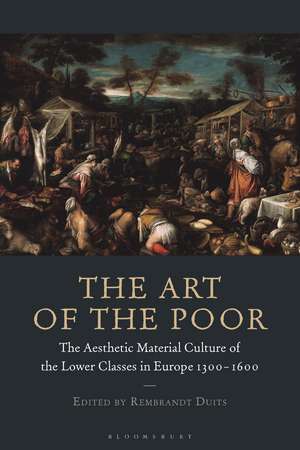The Art of the Poor: The Aesthetic Material Culture of the Lower Classes in Europe 1300-1600
Rembrandt Duitsen Limba Engleză Hardback – 14 oct 2020
| Toate formatele și edițiile | Preț | Express |
|---|---|---|
| Paperback (1) | 199.64 lei 6-8 săpt. | |
| Bloomsbury Publishing – 20 apr 2022 | 199.64 lei 6-8 săpt. | |
| Hardback (1) | 600.06 lei 6-8 săpt. | |
| Bloomsbury Publishing – 14 oct 2020 | 600.06 lei 6-8 săpt. |
Preț: 600.06 lei
Preț vechi: 859.52 lei
-30% Nou
Puncte Express: 900
Preț estimativ în valută:
114.82€ • 120.20$ • 95.01£
114.82€ • 120.20$ • 95.01£
Carte tipărită la comandă
Livrare economică 05-19 aprilie
Preluare comenzi: 021 569.72.76
Specificații
ISBN-13: 9781788316750
ISBN-10: 1788316754
Pagini: 312
Ilustrații: 96 bw illus
Dimensiuni: 156 x 234 mm
Greutate: 0.61 kg
Editura: Bloomsbury Publishing
Colecția Bloomsbury Academic
Locul publicării:London, United Kingdom
ISBN-10: 1788316754
Pagini: 312
Ilustrații: 96 bw illus
Dimensiuni: 156 x 234 mm
Greutate: 0.61 kg
Editura: Bloomsbury Publishing
Colecția Bloomsbury Academic
Locul publicării:London, United Kingdom
Caracteristici
This volume will expand the discourse of art history including an hitherto largely neglected corpus of artwork that has received scant attention
Notă biografică
Rembrandt Duits is Deputy-Curator of the Photographic Collection at the Warburg Institute, London, UK.
Cuprins
List of FiguresNotes on ContributorsPrefaceIntroduction. Did the Poor have Art? Rembrandt Duits (The Warburg Institute, School of Advanced Studies University of London, UK)1. Material Culture without Objects: Artisan Artistic Commissions in Early Renaissance Italy, Samuel Cohn (University of Glasgow, UK)2. Poverty in the Paintings of Jacopo Bassano: The Crisis Poor and the Structural Poor, Tom Nichols (University of Glasgow, UK)3. The 'Slipshot' Nature of Carpaccio's St Tryphon Tames the Basilisk: A Painting for a Poor Confraternity, Thomas Schweigert (University of Wisconsin-Madison, USA)4. '.?? pa?t?? t?? ?a?? t?? ?????? t(??) ???a?.': Communal Patronage of Church Decoration in Rural Venetian Crete, Angeliki Lymberopoulou (The Open University, UK)5. Next to Chur We Are still Poor: Art and the Relationality of Poverty in the Rhaetian Alps, Joanne W. Anderson (University of Aberdeen, UK)6. Miracles in the Margins: The Miraculous Image of Santa Maria delle Carceri in Prato, Shannon Gilmore-Kuziow (Australian Catholic University, Australia)7. The Art of Popular Piety: Pilgrim Souvenirs from the Museum of London Collection, Meriel Jeater (Museum of London, UK)8. Artisans and Dress in Denmark 1550-1650: A Preliminary Exploration, Anne-Kristine Sindvald Larsen (Aalto University, Finland)9. The Art of Artisan Fashions: Moroni's Tailor and the Changing Culture of Clothing in Sixteenth-Century Italy, Paula Hohti Erichsen (Aalto University, Finland)10. Identifying Popular Musical Practice: Instruments and Performance in the Iconography and Archaeology of the Medieval and Renaissance Period in Europe, Roger Blench (Cambridge University, UK)11. An Art for Everyman: The Aspirations of the Medieval Potter, Jacqui Pearce (Museum of London Archaeology, UK)12. Italian Tin-Glazed Ceramics: Silverware for Poor People? Clarisse Evrard (University of Lille - École du Louvre, France)13. Ordinary Objects for Priceless Lighting: Copper-Alloy Candlesticks in Medieval and Early Modern England, Anne-Clothilde Dumargne (University of Versailles Saint-Quentin-en-Yvelines, France)14. Burning Issues: Political Iconography on Dutch Firebacks, Lucinda Timmermans (Amsterdam, Rijksmuseum, The Netherlands)15. Visual Pedagogy: The Use of Woodcuts in Early Modern Lutheran and Catholic Cathechisms, Ruth Atherton (University of South Wales, UK)16. Shakespeare's Picture of 'We Three': An Image for Illiterates? M.A. Katritzky (The Open University, UK)BibliographyIndex
Recenzii
Can we imagine the late Middle Ages and Renaissance without the sumptuous art and material culture they are known for? This book invites us to consider objects that usually linger in museum depots and are rarely depicted in catalogues and offers a new and unique assessment of the more modest, cheaper and mass-produced commodities that those who were not even moderately well-off could afford. In doing so, this collection of essays opens our eyes to the taste and aesthetic of the vast majority of people and to the everyday objects that are its witnesses. From mass-produced tableware, to pilgrim badges and from frescoes in remote villages to candlesticks, firebacks and woodcuts, the essays in this pioneering collection are treading new ground and creating a new field in the study of material culture along the way.
This book is exciting and ground-breaking. It moves the study of the poor beyond depictions of need and charitable response, demonstrating how the lives of the poor were touched by art in their material culture. The multidisciplinary research brings striking insights into the lives of the poor, and shows the wealth of material available to those who seek to understand this large and little explored segment of humanity.
This book is exciting and ground-breaking. It moves the study of the poor beyond depictions of need and charitable response, demonstrating how the lives of the poor were touched by art in their material culture. The multidisciplinary research brings striking insights into the lives of the poor, and shows the wealth of material available to those who seek to understand this large and little explored segment of humanity.
